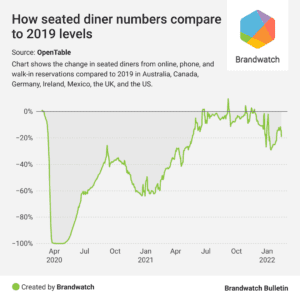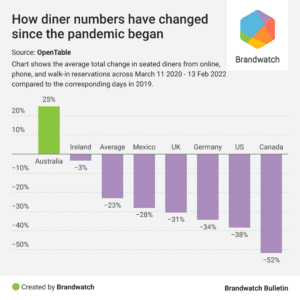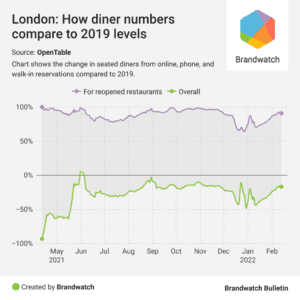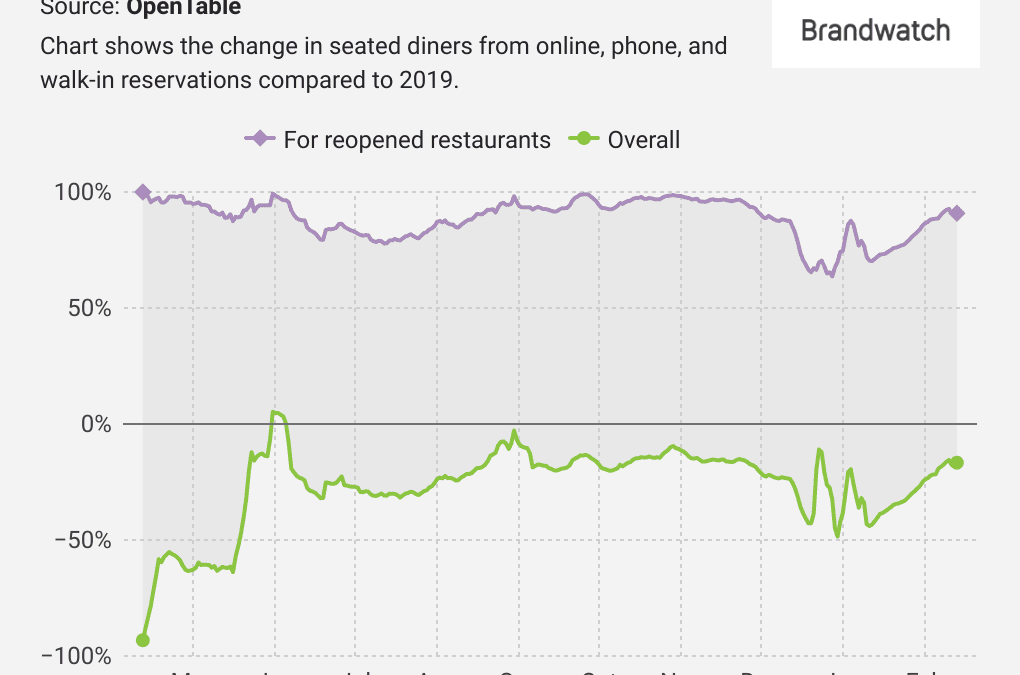In today’s blog we’re using OpenTable data from Brandwatch to see how the restaurant industry is faring in the face of COVID-19, and how well reopened restaurants are doing.
Table data for two, please
It’s no secret that restaurants suffered heavily during the pandemic, but what’s harder to know is exactly how badly and how well the industry has recovered as vaccination rates have increased.
Previously we’ve used restaurant review data to figure this out, but there’s a second option. OpenTable, a major online restaurant-review service, has made their data on diner numbers publicly available.
Thanks to the way the data is formatted, we can clearly see the effect of COVID-19 on the industry. Days are not compared by date as this would lead to comparing different days of the week against each other. That wouldn’t work for the restaurant industry where the day of the week massively influences how many people go out to eat.
Instead comparisons are made between the day of the week across specific weeks. So, for example, comparing the Wednesday of week 14 in 2021 to the same in 2019.

But that didn’t last. The end of 2021 saw a drop and, while there was some recovery going into 2022, there’s still a long, long way to go.
What’s incredibly stark is that, even when things are at their best, the industry has yet to see its fortunes return to pre-pandemic levels in a sustainable way. We’ll come to just how much damage has been done shortly.
First it’s important to note that different countries have different situations.

Meanwhile Australia has fared far better with 25% more diners during the pandemic compared to 2019. That’s staggering, but is a testament to the ingenuity of the restaurant industry there and their ability to increase their seating capacity and fill those seats despite COVID-19. Schemes such as this one supporting outdoor dining in New South Wales will have gone a long way to help.
We should also mention the UK. The numbers would be worse if it wasn’t for the Eat Out to Help Out scheme which ran during August 2020. The government subsidised 160m meals in this time, allowing customers to get 50% off their food, up to £10 per person. While the scheme was active, diner numbers exceeded 2019 levels in the country for the first time before going back into the negative when it ended.
Restaurant resilience
OpenTable has also published data that only includes diner numbers from restaurants that reopened after temporarily closing due to the pandemic. We can zoom into the London restaurant scene to get a nuanced view on how things are looking.

But these numbers in isolation hide a darker reality. Despite the reopened restaurants doing well, London’s diner numbers are way down on their pre-pandemic levels. Why? Because so many restaurants closed permanently. This means despite the demand being there, there’s just not enough establishments to cater for it.
Not only do those closures represent a lot of lost jobs and business but, for countless people, these restaurants had a special place in their hearts, whether as the scenes of first dates, birthday parties, proposals, wakes, or just Wednesday night treats.
It’s obvious the restaurant industry has been scarred by the pandemic, but we should remember the human and emotional cost too.
Here’s to all the surviving and new restaurants, and to the memories that will be made in them. Bon appétit and bonne chance.

